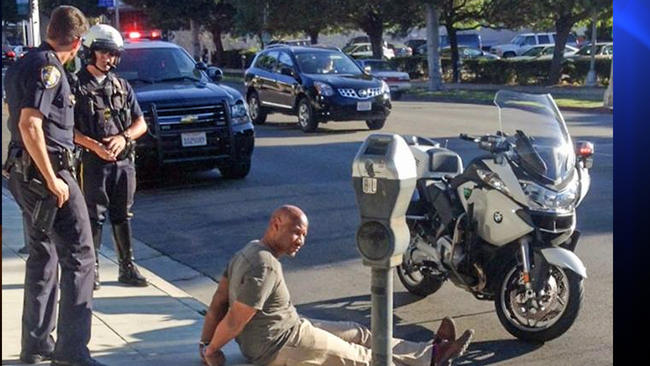By Earl Ofari Hutchinson, Contributing Columnist
Los Angeles Mayor Eric Garcetti has announced the formation of a new community safety bureau within the Los Angeles Police Department.
My question: How does this square with what I saw in one recent week on three separate South L.A. street corners.
A small army of LAPD cruisers rolled up at each scene. Officers jumped out and formed a quasi-military skirmish line. Traffic cones were quickly tossed up. The streets were blocked off. Two police helicopters hovered overhead.
There was no bank nearby, so it wasn’t a bank robbery in progress or a hostage siege. There was no mass of marching, jeering, object-tossing demonstrators nearby. There was no apparent injured party standing or laying on the sidewalk. And there was absolutely no indication there was any gunplay.
So what brought the mad stampede of LAPD officers to those scenes? I stopped and observed to find an answer.
In one case, there were a couple of young Blacks cuffed in a squad car. At another, I saw no evidence of an actual crime in progress. At the third scene, after a few moments the officers stood down and quickly got in their cars and exited the scene.
I take it there was no crime. Then why the quasi military overkill of hordes of cops at the scene for no heavy-duty violent or major crime in evidence on South L.A. streets?
In the era of George Floyd, endless mass anti-police abuse protests, countless arrests and even riots, it’s repeated so often it’s taken as fact. That is that police departments are emphasizing de-escalation not confrontation.
They are revising their policies and procedures on use of force. They are fully embracing community partnerships, and dialogue with Black leaders, activists and community residents.
Garcetti and Los Angeles Police Chief Michel Moore repeatedly make that point. In short, they are firmly on the path to doing what police reformers have been demanding for decades. Namely, police Watts the same way you police in Beverly Hills.
Yet, compare the dual standard of policing routinely reserved for low income Black and Hispanic inner-city neighborhoods versus that for middle- and upper-income white suburbs. In one, the police procedure is massive shows of force, dubious stops, searches, racial profiling and gruff commands and orders.
In the other (unless the person stopped, searched and profiled happens to be a young African American walking or driving through those cities), the police procedure is Mr. Rogers-type courtesy, friendly dialogue with emphasis always on protecting citizens, safeguarding their rights and providing full public service.
Post Floyd, the LAPD and most other big city police officials pay lip service to community policing and reform. However, the streets in South L.A. tell a far different story.
Police officials are under pressure from two sides. The police protesters want an end to militarized, weaponized, armored, combat mode, police state style departments.
However, public officials and many city residents demand that they do their duty and be tough, vigilant and aggressive in enforcing the law.
There’s always the fear that any laxity in these neighborhoods will open the gate to lawlessness. That is what gets police chiefs and commissioners fired.
They are also reminded that they have a legal and public trust to ensure peace, stability and lawful conduct by all citizens.
Pre-Rodney King and certainly pre-1965 Watts riots, the LAPD took this to mean us versus them, take no prisoners, bust a few heads, and of course, the wanton use of deadly force. Police officials winked and nodded at this abuse and violence in South L.A. The targets were almost always young African Americans and Hispanic males.
Countless studies, commission investigations and reports found the same thing. The LAPD was perceived as an occupying army that routinely dealt in deadly force, abuse and discourtesy with a heavy dose of a massive show of force at any hint of real or imagined trouble.
Since Rodney King, the LAPD has revamped many of its policies and procedures on everything from the use of deadly force to racial profiling. A major effort has been made to make the department look like the citizens it polices in L.A.
Those changes were much needed and welcome. However, the LAPD’s gross overreaction to the three scenes I witnessed in South L.A. stands in stark contrast to what I see when police make stops in other areas.
There I see at best one, maybe two officers, politely questioning those who reported an incident or even a suspect.
When the posse shows up in force, it again deepens the suspicion that the LAPD intends to send this message: we are the boss and in total control.
It’s a replay of the occupying army perception all over again when it comes to handling real or perceived crime in South L.A. Whether that’s true or not, the certainty is that the LAPD’s optics still look awful in South L.A.
Earl Ofari Hutchinson is an author and political analyst. He is the author of “Why Black Lives Do Matter” (Middle Passage Press). He also is a weekly co-host of the Al Sharpton Show on Radio One and the host of the weekly Hutchinson Report on KPFK 90.7 FM Los Angeles and the Pacifica Network.












